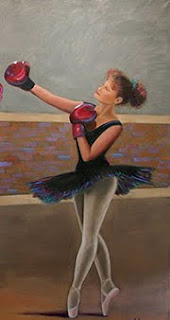Why Fighting on Your Toes is Not Combat Effective
The Art of Movement
Whatever style of stand-up fighting you train in, you have been taught footwork; the art of how to move. The majority of time you’re taught to stay on your toes or the balls of your feet. The reason being it makes you quicker and lighter on your feet. Watch any boxer or mma fighter with great footwork do his thing and he’ll make his opponent look like he’s standing still or moving in slow motion.
The Crutch
But the thing you need to pay close attention to is the surface on which he’s moving on. More than likely that surface will tend to be flat, firm and tight, whether on canvas or vinyl. This is the best type of surface when it comes to fighting for sport competition. While it does have its advantages it can become a crutch and liability when it comes to street-fighting on surfaces that aren’t so smooth and flat.
My Story
Many years ago I use to train in an alley behind my home and sparred and fought with many different styles of martial artists, boxers and street-fighters. I was fortunate to be able to train on different surfaces in that alley, as spartan as it was. You see one area was very gravely, while another side was grassy, still another area was thick asphalt that was sticky.
Then there was an area that was missing chunks of asphalt and it had gravel and dirt in the holes and cracks. There was also a cement slab that was flat and smooth but had a lot of dust on it which made it very slippery. And finally there was an area that was uneven and sandy. I would go out to that alley and train my footwork on all those different surfaces.
I would shadow fight, pivot, and kick figuring out what worked and what didn’t work on those surfaces. I got so good that when I would spar with someone I would watch how he moved and based on that I would guide him to the area that would nullify his footwork and style. For instance if he was a kicker I would fight him on the gravel or the dusty cement floor. If he was a shuffler I would fight him on the sticky asphalt or gravel. And if he fought on his toes or the balls of his feet, I would fight him on the uneven sandy surface or the area with the missing chunks of asphalt. Opponents with wider stances, I would fight on the smooth flat dusty cement slab. Opponents with a more narrow stance I would fight on the sand or uneven area.
Wow! I just gave you a lot of information on fighting on different surfaces.
Go back and re-read this last section, there is so much to learn from my alley fighting days.
By the way the best footwork pattern I used on all these surfaces was…
Change Up
Before I spill the beans, I just want to make sure that you understand that if you are accustomed to fighting on smooth flat surfaces, you'd better change up.
Fighting on the street or fighting for your life is a lot different than fighting to win a round or trophy. So is the surface you'll find yourself fighting on. I suggest that you start training seriously on different surfaces and find out what works and doesn’t because the worse time to figure it out is in the middle of a fight. Experience is the worst teacher, because it gives you the test before you learn the lesson.
Get Outside
So go outside your gym, pick a surface and start working on your footwork and fighting style.
Then find a different surface you haven’t trained on and practice on it. Learn to get comfortable on uncomfortable surfaces with your fighting skills.
Partner Training
Find a workout partner and have him slowly attack you like as if it were a real fight and see how you adapt to your environment. Once you get use to it have him go harder and faster, look for the flaws in your fighting and fix it. Throw your punches, knees, elbows, and kicks, try everything you would do in a real fight on these surfaces.
Learn what it is that will keep you alive, if and when the need arises.
What Worked for Me
Now, the footwork pattern that worked best for me was a more flat footed, stomping type of movement. Also a slightly raised heel footwork pattern worked. These two types of footwork worked for me based on how I fought.
I encourage you to stop dancing like a ballerina and train your footwork for combat, and learn what works best for you.
Now step to it.
Daniel Sambrano
www.SuperHeroSystems.com

like you my friend I train on 5 different surfaces a week (all in the same gym) and alll of them present different difficulties.
ReplyDeleteNot only are your recommendations good ones, I would add that the individual should concentrate on learning how to drop and stomp, instead of step and slide on any and all surfaces.
Not only will thier footwork remain solid and balanced - they'll be surprised by the amount of power thier techniques demonstrate.
That is if they learn how to do it correctly
I just want to say to both Donnie and Daniel, Thank you. I live in NY and don't get to train with you guys(although I wish I could) but I read this blog and watch the videos all the time and the info given is so useful and valuable, Thanks again. Paul
ReplyDelete